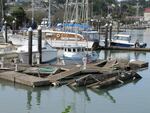In the event of a distant tsunami coming to the Oregon coast, you might not expect boat owners to head out to sea.
But that’s what many commercial and sports fishers do — to protect their vessels from the groundings, capsizes and collisions in harbors when tsunami waves near the shore. In deep water, a passing tsunami is such an elongated hump that sailors might not even notice.

Damage at the Port of Brookings after the tsunami from Japan in 2011.
Kristian Foden-Vencil / OPB News
The state has released the first in a series of local advisories showing coastal boat operators where to go and what to do in the event of a distant tsunami.
Back in 2011, when boat owners heard a tsunami was on its way to the West Coast from Japan, many headed out to sea. The passing tsunami wasn’t a problem for them. But in Crescent City, California, for example, the fleet couldn’t return because of harbor damage.
Jonathan Allan, with the Oregon Department of Geology and Mineral Industries (DOGAMI), says to make matters worse, a storm was approaching.
“It presented some challenges because people were evacuating quickly and weren’t necessarily adequately prepared, both in terms of having support staff on their vessels, you know fuel, etc. to be out there for extended periods of time, or food etc.," he said. "And so they were having to come up with alternative options for where to safely move to.”
Those who didn’t have enough fuel returned to Crescent City, but had to anchor in some unusual spots.
Others had to sail to Humboldt Bay or Brookings Harbor, in Oregon, ports that some captains had never negotiated before.
The new DOGAMI advisory's focus on a distant tsunami is important.
When a Cascadia Subduction Zone earthquake hits right off the Oregon coast, the resulting tsunami is expected to reach land in about 10 minutes. So there won't be time for boaters to head out to deep water.
But if the earthquake happens in Alaska, boat operators will have about four hours; if it occurs in Japan, they have about nine hours.
In 2011, after the Japan earthquake, what boat owners did in the end was keep close contact and help each other out.

Marina damage near Chetco River, Ore., following wave surges from the March 11, 2011 tsunami off the coast of Japan.
U.S. Coast Guard
Allan says the state’s new advisories focus on Newport and Toledo, but other locations will follow. “The regionally-released map is the first of its kind on the Oregon coast for a specific port community," he said "It’s providing information to recreation and commercial boat operators as to the types of responses they can take in the event of a distance tsunami taking place.”
Terry Thompson is a commercial fisherman and a Commissioner for Lincoln County, and he thinks the advisory will help boat owners make good decisions. “A lot of people think they’re just going to go a short distance off shore," he said. "They don’t realize that in a major tsunami, they’ve go to get outside of 100 fathoms. In a distant tsunami - that would be one like in Alaska or Japan - they’re going to have to get a shorter distance."
In Newport and Toledo, that "shorter distance" could still take a couple of hours to reach. Boat operators would have to reach an area where the water was 30 fathoms - that is water at least 180 feet deep.
Thompson says when the next tsunami hits, boat owners need to take account of more than just the new map — they need to ask themselves questions like: "What’s the weather forecast?" and "How much time do I have?"
“Can you get to port and get up the hill before the tsunami hits, is the question," he said. "In a distant tsunami, I’d have a chance. In a near shore tsunami and I’m off shore, I may just gamble for going to the deep, but I may be out there for a while.”
Walter Chuck’s small fishing boat was out of the water in 2011, so he didn’t have to make any difficult decisions. But he served on the committee that put the new advisories together.
He said some people wanted more details included. But he disagrees.
“I think if the plan was too detailed and there were too many steps, I think that in essence you would give someone a false sense of security that if you followed this plan, you would be okay," Chuck said. "And in the event of a disaster, everything is very variable.”
He says when the next tsunami hits, he’ll monitor the marine channels and take advice from the U.S. Coast Guard.

